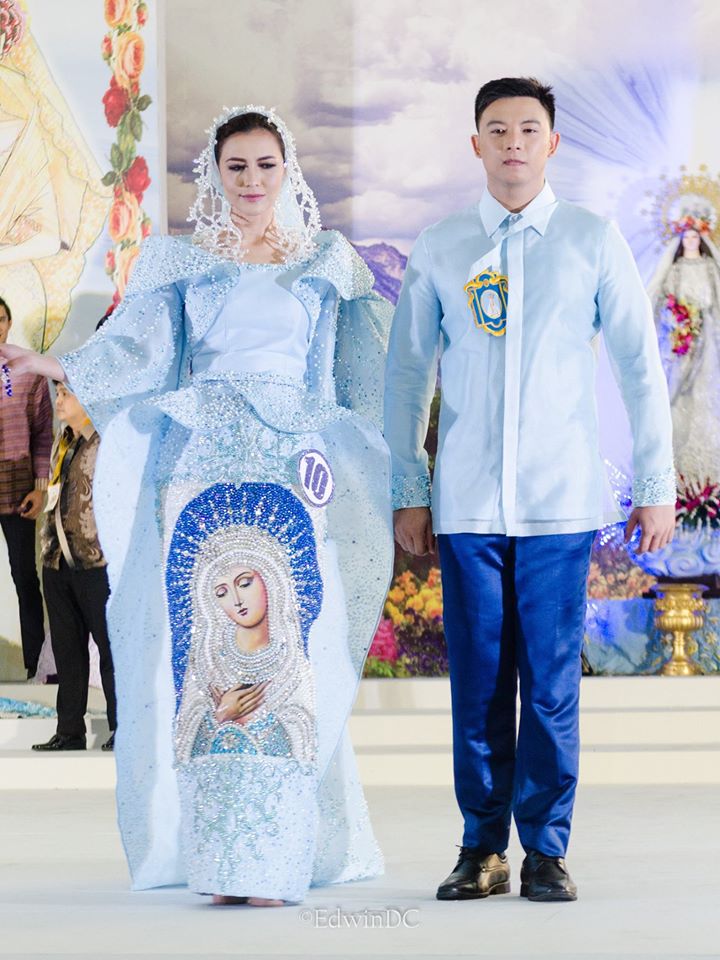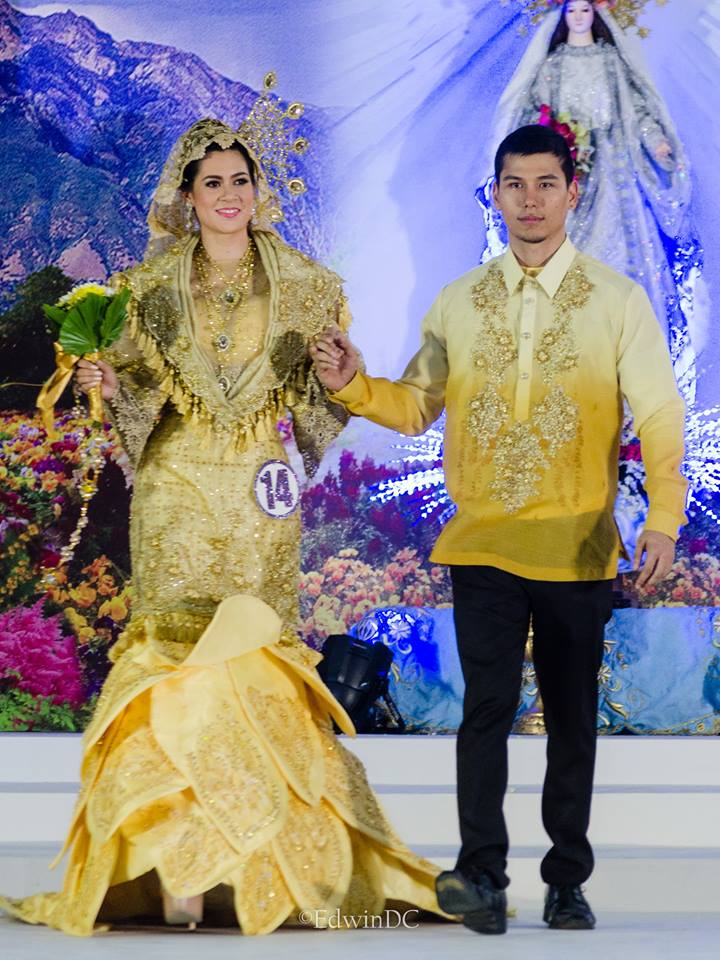Filipino designers honor Our Lady of Fatima in Flores de Mayo

Thirty designers from across the Philippines showcased the best in Filipiniana finery in this grandest and biggest of sagalas. Photos by Louis Pangilinan and Edwin DC (Work with ME Studio)
MANILA, Philippines — Last May 13, Pope Francis canonized the two youngest saints of the Catholic Church who did not die as martyrs, the siblings Jacinta and Francisco Marto. Both were beatified by Pope John Paul II on May 13, 2000. The shepherd children, together with their cousin Lúcia Santos, witnessed the Marian apparitions in 1917 at the Covada Iria, in Fatima, Portugal.
The Blessed Virgin Mary who appeared to the children was bestowed the Roman Catholic title of Our Lady of Fátima (Portuguese: Nossa Senhora de Fátima, or formally known as Our Lady of the Holy Rosary of Fátima, Nossa Senhora do Rosário de Fátima).
On the 100th anniversary of the apparitions, the Congregacion del Nombre del Jesus, a group devoted to the Holy Child Jesus, celebrated the milestone with the 38th edition of their famed Flores de Mayo at the Mall of Asia Arena, with support from the City of Pasay and the Department of Tourism. It was directed by Congregacion member Ogee Atos.
Thirty designers from across the Philippines showcased the best in Filipiniana finery in this grandest and biggest of sagalas, with designers from Bulacan, Laguna and Quezon joining their Metro Manila colleagues. Veteran designer Pepe Quitco represented Mindanao with his distinctly indigenous adherence to the theme.
With this wealth of talent on display, each creation was elaborate, intricate and exquisite. But some are bound to stand out. The designers explain their creations:
Ole Morabe: "It’s a 1920s-inspired baro’t saya in French chantille lace enveloped by high-grade tulle marquiset in peach bordered with alencon lace traced with seed pearls, crystals and nacar. The skirt cut in trumpet silhouette is of the same color with the tapis in chatreuse green with column pattern swagged with varied sizes of pearls. Sagala Jasmin Trias has a veil with peineta to complete the look."
The barong Tagalog, worn by escort Robert Daniel Dulfo, is inspired by 1920’s Teniente Mayor and of the same fabric, paired with black pants.
Rowell Panlilio: "For my sagala, Jhen Maica, I used Spanish brocade lace lining with soft American tulle full sequins and indigo taffeta. From an ivory base, I used spray paint to color it into mint green ‘ombre pattern,’ embellish it with ‘banig’ and floral personalized lace design accentuated with semiprecious stones and Japan-cut glass an abacus crystals. This was inspired by Maruja’s trademark bell sleeves and full lace sanepa veil."
Arcel Yambing wore a cocoon barong Tagalog with laser-pattern lace with Swarovski crystal buttons.
Rey Lazaro: "My Fatima-inspired gown is a modern adaptation of a Maria Clara silhouette in honor of the Blessed Virgin Mary. The icon on the skirt was hand-painted and embellished with beads, different sizes of pearls, crystals and rhinestones. The veil of my sagala, April Tanhueco, is made of crystals in a spider-web pattern."
To complement the skirt, but not to overpower the painting, which is obviously the highlight of the design, five sizes of pearls and Swarovski crystals were used in shades of light green, turquoise and white.
"My panuelo, instead of using the traditional folded pattern, I made it to look like a bolero to complement the oversize tulip sleeves. Using the same tulip pattern, I used it for the tapis extending it to the train."
The escort, Mark del Rosario, wore a simple tailored-cut barong Tagalog with same embellishments at the cuff, with an embroidered scapular with the image of Our Lady of Fatima.
Yeye Pantaleon: "My inspiration were the devotees and followers bringing flowers for our dear Lady of Fatima. The vibrant colors give radiance and life. It feels good within, it’s like springing forth hope and light. The fabric I used for my sagala, Irish Nobleza, was tulle with crystals and pearls embellished on the gown, a serpentina dress with a double portrait collar and bell-sleeved jacket to match the look of the panuelo.
But, of course, I made it a bit modern and as always with my signature touch. And that is, the process itself. My team and I made a Do-it-Yourself floral print using hundred thousands of crystals and thousands of pearls, all manually put and attached to the gown with our bare hands. We honor our dear Fatima, so the labor and hard work were all worth it. I am more than blessed to have this chance."
As for the escort, Rafael Adzuara, the designer got inspired by how Filipino men courted and bedazzled women way back. The traditional courting of not just the women in particular, but the whole family. The giving of flowers for the lady, waking up early to fetch water for the family, the wood chopping and all that jazz! And most especially, the traditional harana.
"So, I chose a traditional barong Tagalog for the escort, accentuated it with our DIY floral crystal print but ever careful so as not to over-accentuate it and overwhelm the gown. My color is pink specifically, so I had to be very cautious and keen on the embellishments, since I do not want to create an overkill. Again, it was manually labored by me and my team, all for the honor of Our Lady of Fatima."
Edwin Uy: "My neoprene gown, worn by Laura Lehman, is a Filipiniana that has the basic elements of a mascota (famous in Zamboanga), a panuelo, kimona (with traditional bell sleeves) and tapis. My basic color is powder pink but I used gold and wooden materials to accent the gown for a more Filipino look. The image of our Lady of Fatima at the front and the brocade panuelo accentuate the gown.The skirt is a serpentine-cut gown with two layers of biased fabric embellished with lace."
Don Cochico wore a traditional ecru barong Tagalog in silk cocoon with Chinese collar but it is somehow modern because of the use of pink embroidery mixed with gold lace as accent. Gold pants complete the look.
Rholand Roxas, given the “La Flor de Pasay” citation: "My creation is a Filipiniana, a baro’t saya made of pina, beads, sequins and crystal stones. The embroidered gazar gown worn by Rica Mediavillo,is a serpentina, double balloon over bias skirt with the hem traced with sequins.
The barong Tagalog, worn by Felix Argales, was made of pina, with embroidery the same as the sagala’s skirt.
Louis Pangilinan, adjudged “La Flor de Manila”: "My creation for Jeremie Rivera, is a millennial Maria Clara gown, a traditional Filipina dress with a modern twist. It is composed of four pieces: the camisa is made up of callado fabric embellished with embroidery patterns and gemstones, the saya is a constructed serpentine cut highlighted with stained glass patterns and the cross that symbolizes the event which is ‘Santacruzan,’ the tapis is intricately beaded with gems and rhinestones with embroidery and accentuated with dangling tassels, and the panuelo is also made up of callado fabric beaded with gemstones and designed similar to the dramatic windows of a cathedral. Overall, I still make it a point to preserve the image of our national costume and at the same time entice the millennials to appreciate our own culture."
Jontie Martinez, adjudged “Reina de las Flores”: The traditional Maria Clara ensemble, worn by Miss Philippines Air Shannon Bridgman, is a butter-yellow organza. The tapis and panuelo are intricately embellished with gold corded lace and beadwork while the multi-petaled mermaid skirt is embroidered with paisleys and intertwined ferns.
Raph Almeda wore a matte gold monochromatic dyed jusi barong appliqued with gold corded lace embellished with glass beads and pearls, and paired with jet-black wool slacks.
Vince Sityar, given the to citation “Rosa Mistica”: "My sagala, Stephany Stefanowitz, wore a duchesse gown in duchesse satin, superior satin and gold laces. It is embroidered with Marian emblems. The barong Tagalog, on Harvey Cruz, was made of jusi with classic embroidery.
The back skirt detail of my Maria Clara was inspired by the glamorous vestment of Our Lady of Manaoag by Kim Gotal Vallado of House of Gold Threads and Embroidery. The hand-painted image of the Fatima is by Mark Lester Mempin; Gold Thread Scapular by Mark Anthony Alonzo of RegalíaSacred Vestments; Meticuloso by Bong Sierra Carreon; rosary made of fresh water pearls by Allen Mella-Perez of Rosary By Allen Perez; pearl earrings by Hoseki Jewelry Art, Knoi Austria Esmane and Rum Corvera; pearl necklace by Dave Arden; Vara Alta by Doc Jerome Navarro; and gold embroidered veil by El Perro Amante Estrella."
"It’s been four years since I started to be part of this prestigious event, and yearly it’s always a dream come true. Being part and to be one of the designers in the Flores de Mayo together with other top Filipino designers who have names in the industry is such a huge privilege and honor for every designer. And winning any title and award is just a bonus prize."

Creations by Yeye Pantaleon, photo by Edwin DC (Work with ME Studio)

Creations by Vince Sityar, photo by Collin Yap of Fab Manila.

Creations by Rowell Panlilio, photo by Edwin DC (Work with ME Studio)

Creations by Rey Lazaro, photo by Edwin DC (Work with ME Studio)

Creations by Pepe Quitco, photo by Edwin DC (Work with ME Studio)

Creations by Ole Morabe, photo by Edwin DC (Work with ME Studio)

Creations by Louis Pangilinan, photo from his Facebook page.

Creations by Jontie Martinez, photo by Edwin DC (Work with ME Studio)

Creations by Edwin Uy, photo by Edwin DC (Work with ME Studio)

Creations by Rholand Roxas, photo by Edwin DC (Work with ME Studio)



















